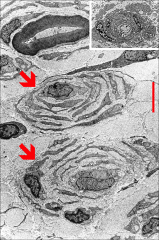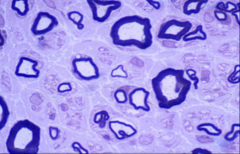![]()
![]()
![]()
Use LEFT and RIGHT arrow keys to navigate between flashcards;
Use UP and DOWN arrow keys to flip the card;
H to show hint;
A reads text to speech;
33 Cards in this Set
- Front
- Back
|
Damage to a single nerve or nerve group that leads to loss of function or sensation of that nerve
|
Mononeuropathy
|
|
|
Symmetric dysfunction of multiple nerves simultaneously, with effects usually greater distally
|
Polyneuropathy
|
|
|
Loss of nerve function caused by damage to nerve roots (i.e. from herniated spinal disc), usually painful, and often in dermatomal distribution
|
Radiculopathy
|
|
|
Group of symptoms related to damage of one or more peripheral nerves in random distribution, usually from vessel or connective tissue disease (i.e. DM)
|
Mononeuritis multiplex
|
|
|
What happens to the distal segment of an axon after axonal transsection (i.e. cut in the axon)?
|
Anterograde (Wallerian) degeneration
-axon and myelin break down, removal of debris by macrophages |
|
|
What two things can happen to the cell body after the axon has been cut or damaged?
|
-Cell body shrinkage (neuronal atrophy)
-Retrograde cell body death |
|
|
After injury, what changes occur with regards to protein synthesis organelles?
|
-Chromatolysis - loss of RER and Nissl substance
-also change of nuclear positioning -swelling of cell body |
|
|
Rough ER/Nissl substance are lost but what structures are present instead?
|
Polyribosomes - present during cell growth
|
|
|
In order to regenerate, neurons need what intrinsic property?
|
Metabolic ability to regrow
|
|
|
In order to regenerate, what extrinsic 4 extrinsic criteria need to be met?
|
-"permissive" extracellular environment
-cellular terrain provides cues -axon can respond to these cues -ability to compensate for neuronal loss |
|
|
During development, this structure is sent out to "taste" the environment and extend the axon in the right direction. It also forms and begins the regeneration process at the proximal site of the injured axon.
|
Growth cone
|
|
|
What cells are crucial to encouraging the extension of the growth cone/making sure it encounters a "friendly" environment in the PNS
|
Schwann cells
-produce adhesion molecules growth cone can "stick" to |
|
|
Regrowing axons are initially myelinated or unmyelinated?
|
Unmyelinated
|
|
|
T/F Axons will be present in the microenvironment distal to the site of axotomy in a peripheral nerve.
|
FALSE - NO AXONS
SCs, fibroblasts, collagen, axonal debris, macrophages, degenerating myelin, vascular elements will be present |
|
|
The rate of regeneration of the axon is similar to that of what kind of transport?
|
Slow anterograde axonal transport
-makes sense because transporting cytoskeletal elements |
|
|
Which has a better chance of regeneration - an axon damaged by a crush injury or an axon damaged by a transection injury?
|
Crush - some of axon still there and can regenerate better than if severed completely
|
|
|
T/F Distance of the gap between the axon proximal stump and the microenvironment plays a role in regeneration
|
True - greater distance, worse outcome
|
|
|
Besides gap distance, what other factor is important to whether or not regeneration is successful?
|
Nerve internal geometry
|
|
|
Lack of innervation can lead to what happening to muscle?
|
-Muscle atrophy ("denervation atrophy")
-from lack of trophic factors and lack of activity |
|
|
For peripheral nerves, _______________ is more important for regeneration than vigor (ability to regrow).
|
Accuracy (A function of proximity - so the closer the better)
|
|
|
What is secondary demyelination?
|
Loss of myelin as a result of loss of the axon (Wallerian degeneration)
|
|
|
What is primary demyelination?
|
Loss of myelin from an intact neuron
-Occurs in MS, Guillan-Barre syndrome |
|

What is the "onion bulb change" depicted above?
|
Results from repeated cycles of demyelination and remyelination
|
|
|
How does new/regenerated myelin compare to old myelin?
|

It is thinner and shorter than original segments
|
|
|
What are the two major problems in CNS pathology? What are the two basic forms of neuronal loss?
|
-Neuronal loss, axonal damage
-Necrosis and apoptosis |
|
|
What is secondary tissue damage or collateral damage?
|
A site of necrosis from trauma (i.e. stroke) triggers apoptosis in surrounding areas
|
|
|
What are the two major mechanisms of secondary tissue damage?
|
-excitotoxicity
-free radical formation |
|
|
What is excitotoxicity? What two neurotransmitters are involved?
|
-unregulated release of glutamate and aspartate (excitatory AAs/neurotransmitters) causing cell death by overactivation of neurotransmitter receptors
|
|
|
What can break down free radicals for neuroprotection?
|
Antioxidants - Vit E, C, and beta carotene
|
|
|
What component of the cell is affected by free radicals and excitatory AAs?
|
cell membrane - breaks down and becomes more permeable to Ca2+ causing cell death
|
|
|
What is transneuronal degeneration?
|
-Damage to axons or demyelination can disrupt axonal pathways/neuron networks and cause damage to other neurons in the network
|
|
|
T/F As a rule, there is limited cellular regeneration in the CNS.
|
True
|
|
|
Why is regrowth limited in the CNS?
|
-Environment is not permissive (upside - CNS protects itself, downside - limited regrowth)
-cell have metabolic capability but bad environment (no SCs, removal of cellular debris is slow) |

